202200311 SEL Brief
The post 202200311 SEL Brief appeared first on Search Engine Land.
80% of customers agree the experience a company provides is as important as its products or services. That’s why enabling more human conversations through 1:1 personalized journeys drives loyalty and engagement for consumers, translating to growth and efficiency for your business.
But getting started on the personalization path is easier said than done, especially with competing priorities across your business’ teams.
Register today for “Crawl-Walk-Run to Real-Time Personalization,” presented by Salesforce and take your customer-centric approach to the next level.
The post Crawl, walk, run to real-time personalization appeared first on Search Engine Land.
Twitter has introduced a new experimental ecommerce feature it calls Twitter Shops. Brands who want to create a shop can curate up to 50 items to include, which Twitter uses can then buy via an in-app browser from the merchant’s website.
After a brand or business enables a Twitter Shop, a new “View shop” button will appear on its profile page, directly above its tweets. It looks like this:
For now, only iPhone users can view and interact with the shops. This is much the same way the Twitter Shop Module was rolled out last year. That feature was more limited, allowing brands to show up to five products on their profile, in the same location as the Twitter Shops “View shop” button.
Availability. Twitter only mentioned five brands that have enabled their shops. Those are:
Twitter Shops is only available to select merchants and managed partners in the U.S., according to Twitter’s blog post. Twitter isn’t charging brands to open a Shop.
What it looks like. A Twitter Shop contains a product image, product name, product type, and price.
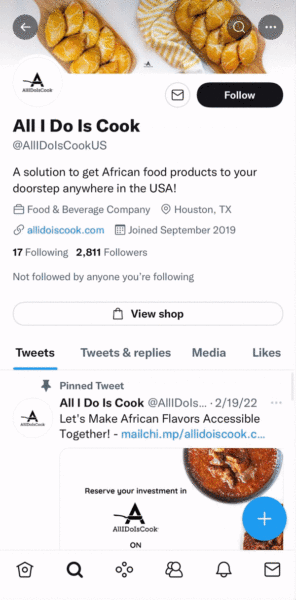
What Twitter says about Shops. “People are already talking about products on Twitter. We want Twitter Shops to be the home for merchants on Twitter where they can intentionally curate a catalog of products for their Twitter audience and build upon the product discussions already happening on our service by giving shoppers a point of action where a conversation can become a purchase.”
Why we care. Social commerce is one of those areas that brands would love to crack. Facebook, Instagram, and other social networks have rolled out similar shops. While Twitter has fewer users than those networks, it’s all about getting your product in front of potential customers, wherever they are. So if your target customers use Twitter, it may be worth testing out Shops to see if it can help drive any sales.
The post Twitter Shops lets brands showcase 50 products appeared first on Search Engine Land.
If you’re just getting started with Google Data Studio, you’ve probably experienced blank-page syndrome.
You get your data source connected, open up a new file, and you have no idea what to do next.
There are no instructions. No guide rails. Just you and an empty page to fill.
And while you can start with a template (Google Data Studio Report Gallery has several), it’s still tough to know how to customize it to perfectly fit your needs.
Here are some tried-and-true elements to include in PPC dashboards and reports that will banish blank-page syndrome and give your stakeholders the insights they crave.
When you add a chart in Google Data Studio, you select the data source, dimensions, metrics and date range from the Data Panel to populate your visualization.
But your reader doesn’t see the Data Panel and won’t know what your chart is about unless you take an extra step to include it in your dashboard.
The two graphs below show identical data visualizations. Figure A includes only the chart, while Figure B includes written titles and context.
Figure A leaves questions in your reader’s mind that Figure B answers.
You can make your graphs and tables easier to understand at a glance with these tips:
How to do it:
It’s worth the small manual effort it takes to add a text box and include context!
You don’t need an article to tell you that your dashboard should include your key performance indicators (KPIs).
But while you’re planning out your dashboard, pay special attention to where to include them.
Your KPIs matter most in your report and deserve top billing.
That means showcasing your KPIs with scorecards like so:
Not as afterthoughts at the end of a table:
Not only do tables make it hard to identify KPIs, for languages that are read left to right, tucking KPIs on the far right of the table tells your reader these metrics are low priority.
Keep your reader focused on your key growth metrics like lead volume, revenue, or return on ad spend (ROAS), rather than vanity and traffic metrics like impressions and clicks.
How to do it:
Having KPIs appear in tables and other charts isn’t a problem, but give them added attention by using scorecards.
Some advertisers use fixed monthly or annual marketing budgets with no room for adjustments.
Others have sales or efficiency goals they need to hit with flexible budgets.
No matter what the approach, your dashboard should answer the question:
Are we meeting our objectives, and how do we know?
Account objectives aren’t standardized, and neither is the approach for including goal pacing in your dashboard.
Fortunately, Data Studio gives you many options for adding objectives and pacing, from literally charting against a goal to adding a written description of the target.
Here are some examples of how you might anchor performance to a goal:
How to do it:
Including goal pacing gives your reader confidence in how to interpret performance data.
Trends and historical comparisons let your reader know if things are improving – or need improvement – over time.
Maybe you fell short of the goal, but you always miss it because it’s unrealistic.
Maybe you hit your goal, but you’re down compared to last year, and you need to take corrective action.
Don’t make your reader wonder whether current performance is average, down or “best month ever.”
Tables and scorecards give you an easy way to show your reader how performance for this period compares to another, using color-coded arrows to indicate the direction of the change (delta).
How to do it:
You can get a complete picture of performance trends using time series charts.
Rather than just comparing this period to the last period, you’ve got an entire history revealing trends in seasonality, market impact and more.
You can use a continuous Time series chart (shown above) or designate a comparison time period.
Here’s how that same data looks as a Year over Year (YoY) Time series chart. Note that the comparison year will show as a lighter shade of this period’s line:
Another way to show historical performance is with a line chart that uses a time period as a breakdown dimension.
This Line chart is from a report comparing CPCs before and during the Covid-19 pandemic:
How to do it:
A few important notes for trends and historical comparisons –
Okay, so tables aren’t that glamorous.
But if your Data Studio dashboard doesn’t have a table, something’s probably missing.
Why? Because there are times when your audience needs to compare multiple categories across multiple metrics. And nothing does that more efficiently than a table.
Tables are great for comparing default categories like:
And depending on the complexity of your PPC dashboard, you can create tables for:
How to do it:
It’s easy to build tables and add metrics, and it’s easy to get carried away. Exercise some restraint and limit the number of metrics in your table, so it remains useful to your reader.
Our list constrained us to five categories, but here’s one bonus for making it to the end:
Shiny charts.
What are shiny charts?
Shiny charts are visualizations that your audience loves and gets excited about, even if they’re not super actionable.
Your readers may not learn anything new, but they’ll feel like they learned something new.
Maps are a great example.
Many dataviz experts say not to use map charts; there are better ways to communicate location data.
But try to find a client or stakeholder who doesn’t love to see performance data on a map. Go ahead. I’ll wait.
Sure it’s a bit counterintuitive when you’re trying to build out an actionable dashboard. Maybe even a bit controversial. And you don’t have to do it. But a chart that makes your audience feel good just for seeing it has its own merit.
While your Data Studio dashboard can technically include whatever you want, it should at a minimum include:
These don’t need to (and can’t) all be discrete sections. One scorecard can include a title, KPI, pacing, and time comparison.
There are many other charts and visualizations that can take your PPC dashboard from good to great. Getting started with this list will set you up for success and give you a dashboard worth the time it took to build.
The post 5 things your Google Data Studio PPC Dashboard must have appeared first on Search Engine Land.
Effective management is important no matter what industry you’re in, but as a loan officer or a mortgage broker, it’s essential. In the lending industry, the way you manage your business does more than help make your dreams a reality. It helps your clients make their dreams come true.
Here are five reasons that effective business management is important for lenders:
Every business is guilty of a bit of “mission drift.” But as a lending institution, it’s vital to remain committed to your common goals. This need applies to the mission of your company itself, as well as the immediate goals of the projects you take on.
Your clients will appreciate a team that stays focused on customer needs. Staff members may also find greater satisfaction in contributing to this common purpose.
Effective management creates consistency and transparency across all business processes. For your clients, this means that they know exactly what to expect, and this deepens their trust in you as a lender.
For example, if you’re a mortgage broker, it’s important to develop a rapport with your clients. Many borrowers are going through the process for the first time. Proper management allows you to be open and transparent about what is going on. This openness can deepen your clients’ confidence in you as well as the lending procedures.
Mistakes happen. But for a loan officer, mistakes can undermine the integrity of your institution. Effective management can standardize critical processes and introduce solutions that reduce errors.
Sometimes, this means using the latest technological resources to make improvements. It can also mean providing the tools and training your staff requires to reduce errors.

Sure, it’s helpful to adopt consistent practices. But it can also be helpful to introduce new ones.
Effective business managers find ways to bring new solutions to the workplace, but they also find ways to listen to the contributions of others. Your team may provide insight that improves the way you handle business or serve clients. By listening to these suggestions, you could change the way you do business.
During the “Great Resignation” of 2021, many employees left their jobs in search of new ones. For some, it was a matter of money, but others felt motivated by their workplace culture.
Effective management creates a space where all team members feel valued and respected. This environment can be important for retaining strong staff members. It also attracts new ones.
The lending industry, as we’ve noted, demands consistency and accuracy. Retaining star employees ensures that you continue to meet these goals. It also means you’ll spend less time training new employees and can stay focused on your clients.
The BNTouch CRM platform has helped over 700 mortgage lenders grow their businesses. Our tools can help you manage your team, as well as promote stronger customer engagement. See for yourself by requesting a demo, and learn how our tools can take your organization to the next level.
The post Effective Business Management in the Lending Industry appeared first on .
Google’s search results for Russian search queries related to Ukraine are almost entirely dominated by a handful of known Russian pro-Putin propaganda publications, such as Izvestia, Russia Today and Ria News.
How is this happening when several credible Ukrainian and Western publications deserving to rank? And how is this happening when Google has stated its commitment to fighting disinformation?
Here’s why Google needs to fix this.
For many Russian language speakers of all ethnicities and nationalities, accessing credible news that’s free from pro-Putin propaganda is difficult – even outside of Russia. And it seems even on Google.
I count myself among this group. I live in Canada and speak Russian. And yet, I was shocked to see publications that broadcast the state-sanctioned narrative ranking so well on Google:

Again, this was just me searching on Google for “Ukraine” results from Canada. Not Russia.
It’s critically important for Russian speakers, many of whom might already find themselves isolated in information bubbles filled with propaganda and conspiracies that justify the war, to have access to accurate, vetted and balanced information about the war when they search for it. That isn’t happening right now.
Sold as a “liberation” and “peace-keeping” mission, the war has a 70% approval rating in Russia. Propaganda fuels a greater ideological divide, with grave consequences.
Russia’s disinformation campaigns are common knowledge. In recent days, western media and tech platforms started scaling back their operations with Russia or cutting ties altogether.
Facebook restricted access to the accounts of Russia’s top media publications, such as Zvijazda, RIA News, Sputnik, Russia Today, Lenta.ru, Gazeta.ru, and others. TikTok is said to have started to remove video content posted to the platform by RIA News, one of Russia’s largest news channels.
One would think that with more than 160 million Russian speakers globally, these restrictions might be a signal to seek better, more credible information elsewhere. But it appears that that “information divide” is also linguistic.
What’s most shocking? Many critical searches related to the events in Ukraine that are executed in Russian on Google return results filled with pro-Putin propaganda.
Among the highest ranking of these publications are RIA News (with more than 1,200 pages indexed for the term “denazification” in Google), Iz.ru, Russia Today, and Ukraina.ru.
There is a vast difference in the type of ranking content when you compare “Украина” versus “United States.”
An exact match Google search for “Украина” (Ukraine in Russian), returns a SERP where, aside from Wikipedia, almost of the results from Russian news sites. This is surprising, as one would expect more results that provide general information and are from Ukrainian domains.
These are the top 10 URLs that rank in Google’s organic results for the search query “украина” (“ukraine”):
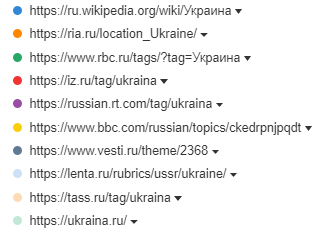
And these are the top 10 results for the search query “United States”:
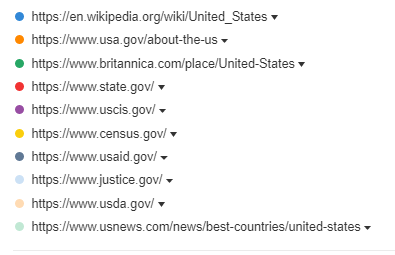
This is a less obvious search query, but search volume has risen within the past two weeks. It has also shown up within Google’s related searches and search suggestions. While there is occasional diversity in the video results, the top organic results are RIA, Izvestia and Russia Today.
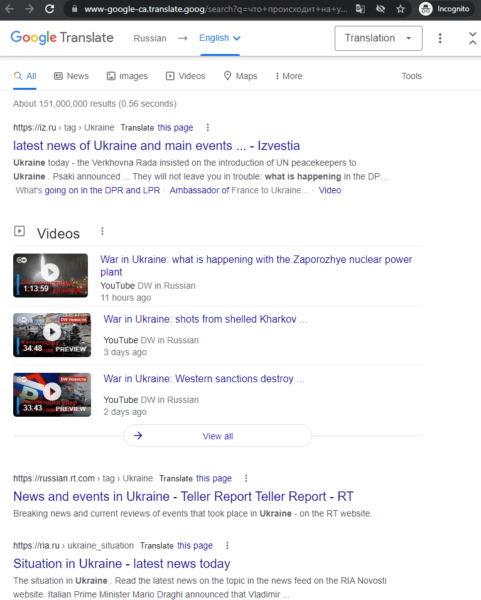
Search queries related to Ukraine news are beginning to see more Ukrainian sites appear in Google’s SERPs, but three out of the five top results are still Russian sites, including RIA and Izvestia.
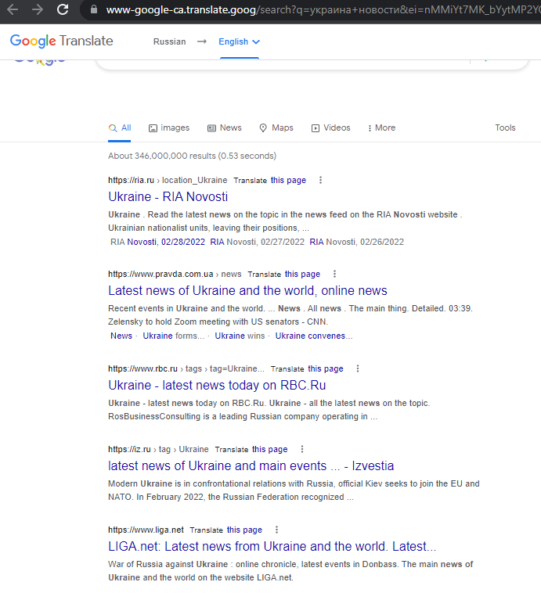
Did you notice that the ranking pages from Russia’s news sites have one thing in common? They are archive pages for tags that match “Ukraine,” not content pages. It’s generally an accepted SEO best practice to noindex archive pages. Many other news websites rank well with their journalistic content. But virtually all of the high-ranking Russian news sites have pursued the strategy of deliberate promotion and link building to their archive pages.
The pages from RIA News, Izvestia and Russia Today dominate the space for search queries (as well as variants and misspellings) of “Украина” (Ukraine), “новости украины” (ukraine news), and “что происходит на украине” (what is happening in ukraine). There is no significant difference between SERP positions based on location (Russia, Ukraine or United States).
RIA News
The best performer, RIA News, has a bare-bones archives page that includes article headlines, images, and other tags, and comes across as an internal linking tactic in itself. There are 20 headlines and over 100 links on the page. No other content.

Izvestia
Izvestia is also an archive page, but it contains more content than RIA. While there are no images, the 15 article snippets include headlines and descriptions. There is a right-hand navigation, as well as a header content block with the tag description, in this case, mentioning that modern Kyiv is in “confrontational relations with Russia” as well as the “military special operation aimed at protecting the civilian population of Donbas.” The page loads intermittently but is accessible via the WayBack Machine.

Russia Today
An established entity with a global presence, Russia Today has the look and feel of a quality news site with good UX, large article snippets that include a headline, description, and image, as well as links to additional content in the right-hand menu.
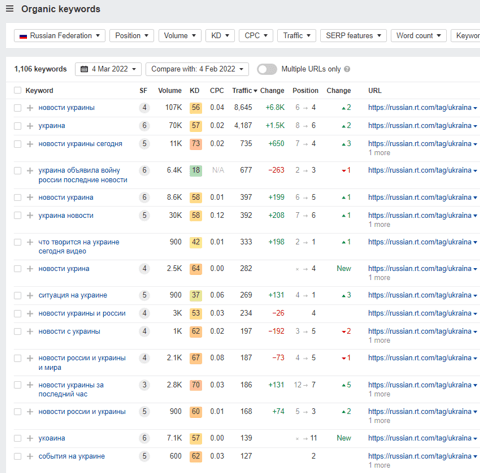
Ukraina.ru
This publication contains a mixture of original content and articles syndicated from other Russian websites. The mission statement that appeared on the site early in its existence, 11 years ago, said that the purpose of the project was to fill the gap in the minds of Russians about Ukraine and to allow Russia to “move West.”
Is there any relevant content from Ukrainian sources that could compete with Russian results? Absolutely. Not even counting Russian language sites by BBC, Deutsche Welle and other credible news sources, there are many Ukrainian news websites that publish in the Russian language.
Microsoft Bing is far more inclusive of Ukrainian sites in its SERPs than Google. Five of the top six Bing results for “Ukraine News” (are Ukrainian (either in .ua TLD or owned by Ukrainians and otherwise located outside of .ru TLD).
In 2014, to fight disinformation, Google introduced YMYL (Your Money or Your Life) content category to its search quality rater guidelines. YMYL is a term used to describe pages and content that can potentially impact one’s happiness, health, finances, safety and more.
Quality thresholds are considerably higher for this type of content. Google states that “YMYL pages should come from reputable websites, and the content should be created with a high level of expertise and authority.”
According to Google, news publications are expected to measure up high journalistic standards, adhere to clear editorial policies, and present clearly researched, vetted and trustworthy information.
Google’s Search Quality Evaluator Guidelines (September 2019) is very explicit about its instructions for content that is harmful to specified groups (7.2), as well as pages with harmfully misleading information (7.3).

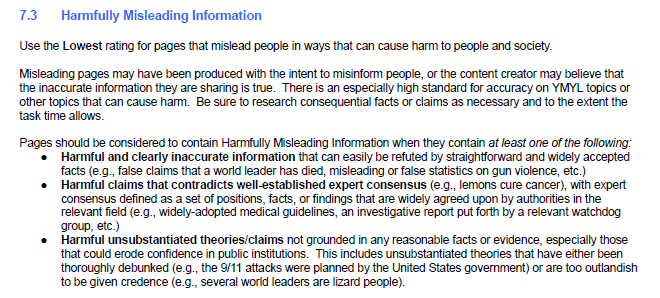
Well, Google, it’s time to hold yourself to the same standards you want media and news publications to meet. It’s time for you to remove the Russian propaganda from your search results. And give Russian language speakers the trustworthy content and information they need.
The post Dear Google: It’s time to remove Russian propaganda from search results appeared first on Search Engine Land.
Russia’s actions in Ukraine have prompted ad suspensions from nearly every platform that search marketers rely on to reach Russian audiences. At first, companies such as Google, Microsoft and Facebook started by restricting ads from Russian state media, but as the conflict continued, many have expanded those suspensions to include all ads that would be served to users in Russia.
Below is a list of platforms and their current policies with regard to the conflict in Ukraine. We will update this resource as platforms update their policies.
Search engines. Google and Microsoft Bing, the two leading search engines globally, have both suspended all ad sales in Russia.
Microsoft Advertising powers ads on Bing, DuckDuckGo, Yahoo! and AOL, so brands currently cannot advertise to users in Russia on those platforms either. While Apple doesn’t operate a search engine, it has suspended Search Ads on the App Store in Russia.
Yandex, which is headquartered in Moscow and the second-most-popular search engine in Russia, is still operating normally.
Social media platforms. Most social media platforms have also rolled out ad suspensions similar to the ones mentioned above.
Why we care. Platforms are responding to the conflict in Ukraine by halting ads as a means to cut down on noise and misinformation, promote the right sources of information and avoid potential brand safety issues. Unfortunately for brands and their audiences in Russia, this also means that there are fewer channels they can use to reach those customers. Knowing which channels are still available to you can help mitigate the impact of these ad suspensions.
The post Platforms that have suspended ads in Russia appeared first on Search Engine Land.
We have learned the tragic news that a member of the SEO community has died. Tatiana Perebeinis was the chief accountant for SE Ranking, an SEO platform.
Tatiana, 43, her two children (Alise, 9, and Nikita, 18) and another man were trying to evacuate from Irpin, Ukraine, when Russian forces fired on them, according to reports.
On Sunday, the New York Times documented the final moments of their lives. (Warning: the article contains a graphic image and video of the mortar attack and the aftermath):
“As the mortars got closer to the stream of civilians, people ran, pulling children, trying to find a safe spot. But there was nothing to hide behind. A shell landed in the street, sending up a cloud of concrete dust and leaving one family — a woman, her teenage son and a her daughter, who appeared to be about 8 years old; and a family friend — sprawled on the ground.
Soldiers rushed to help, but the woman and children were dead. A man traveling with them still had a pulse but was unconscious and severely wounded. He later died.
Their luggage, a blue roller suitcase and some backpacks, was scattered about, along with a green carrying case for a small dog that was barking.
Ukrainian forces were engaged in clashes nearby, but not at the site where civilians were moving along the street. Outgoing mortar rounds could be heard from a Ukrainian position about 200 yards away.
The shelling suggested either targeting of the evacuation routes from Irpin, something of which the Ukrainian authorities have accused the Russian army after a railroad track used for evacuations was hit on Saturday, or disregard for the risk of civilian casualties.“
– Lynsey Addario, New York Times
Tatiana had not tried to leave sooner because she was caring for her ailing mother, according to New York Post.
Here is the complete post that SE Ranking shared via LinkedIn and Facebook, after learning about the death of Tatiana:
“We are devastated to say that yesterday our dear colleague and friend Tatiana Perebeinis, the chief accountant of SE Ranking, was killed together with her two kids by russian mortar artillery.
The family was trying to evacuate from Irpin – a small city right near Kyiv that has been left without water supply, electricity, and heating.
There are no words to describe our grief or to mend our pain. But for us, it is crucial to not let Tania and her kids Alise and Nikita remain just statistics. Her family became the victim of the unprovoked fire on civilians, which under any law is a crime against humanity.
The russian army are criminals, and they should be stopped.
Our hearts are broken. Our prayers are for all Ukrainians, who are fighting for their right to exist.”
The search community is heartbroken by this news. Here is just a small sampling of the comments from SE Ranking’s Facebook post.
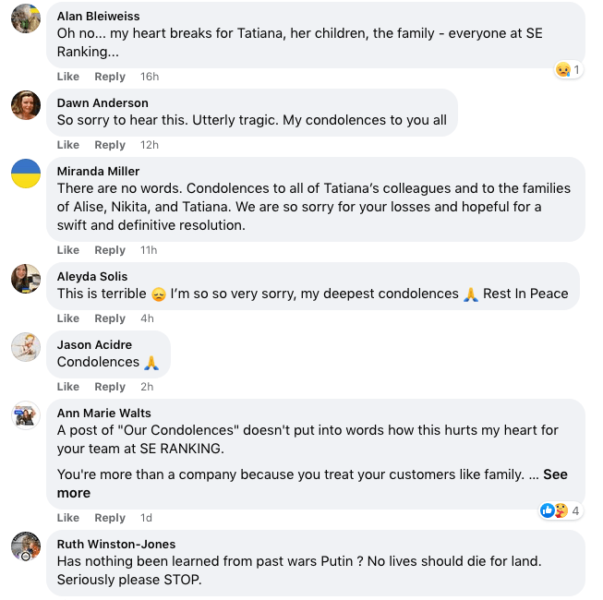
A large part of SE Ranking’s team are Ukrainian. They published a blog post, How You Can Help Ukrainians Today (SE Ranking Team Included), if you are looking for ways to help.
I’m also talking to the SE Ranking team to get additional details and comments on Tatiana, to help tell her story. I will update this article as soon as I hear back.
The post Member of SEO community and her two children killed in Ukraine appeared first on Search Engine Land.